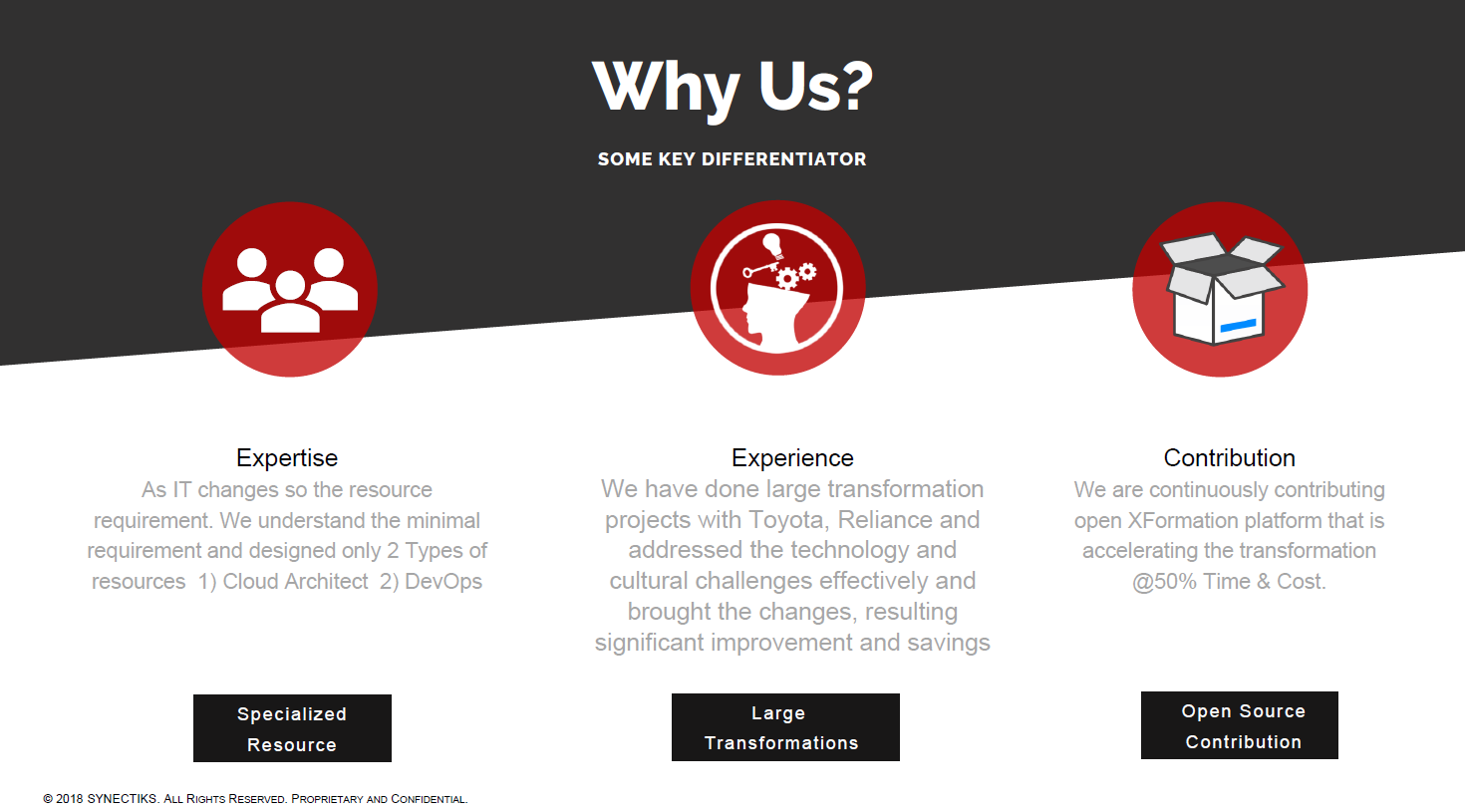Microservices
Microservices Migration
To accommodate the increasing complexity of functional requirements, IT applications have embraced a variety of architectural patterns. Organizations must meet ever-changing business demands — from mainframe applications and client-server to service oriented architecture (SOA) and microservices.
Microservices architecture is a combination of successful and proven concepts of software engineering such as agile software development, SOA, API-first design and continuous delivery (CD). This architecture and organizational approach to software development is designed to accelerate development cycles, foster innovation and ownership and improve the ability to maintain and scale applications.
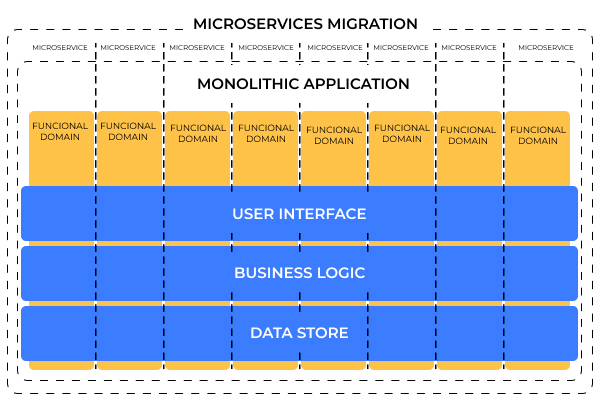
Despite technological advancements, 90 percent of business IT applications are legacy and what are known as “monolithic”. These range from mainframe apps where UI, business logic and data storage reside on machines, to client-server applications where layered technologies that support UI, business functionality and data are stored horizontally. Microservices architecture, on the other hand, divides the functionality into cohesive verticals by implementing a specific domain.
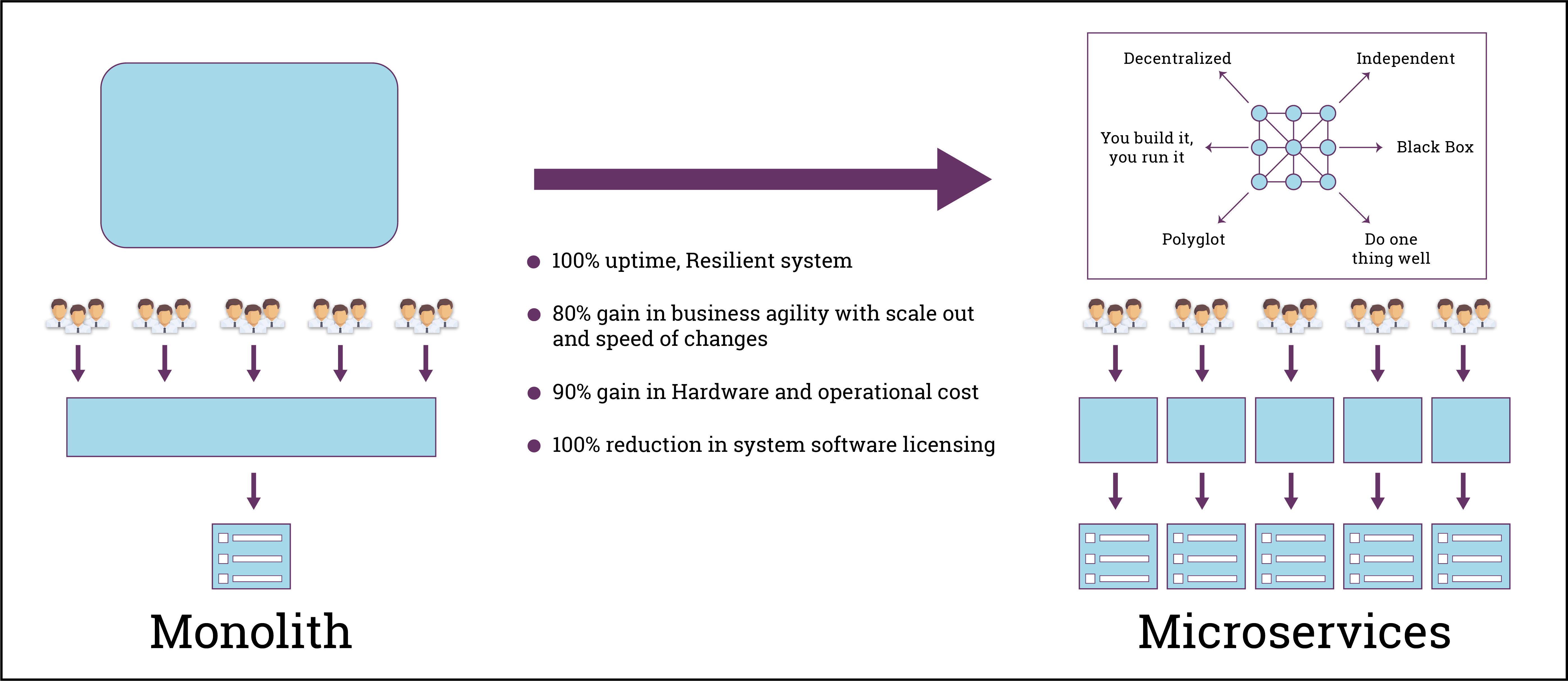
Product Quality.
- Optimize Scalability: React fluidly with smaller, self-contained components
- Achieve High Quality: Continuously and confidently develop and test
- Maximize Resource Utilization: Utilize containers for efficient infrastructure consumption
- Minimize Downtime: Perform isolated maintenance
- Increase Reuse and Decrease Overhead: Encourage sharing on API driven architecture
Process & Culture.
- Streamline Feature Development: Sprint faster to keep up with changing needs
- Increase Innovation: Reorganize into domain specific, end-to-end service teams
- Avoid Tool/Expertise Lock-in: Choose the best technique/technology for the specific problem
- Adopt Existing Third-party Tools: Integrate easily into API driven ecosystems
- Grow User Base/Expand Market: Extend capabilities to external parties
- Enable Business Consumption: Solve small problems with measurable outcomes
Maintaining monolithic applications often proves challenging because it’s difficult to test and release millions of lines of code for tiny changes (in most cases only a few lines). But migrating to microservices is not as simple as it sounds. It requires a big change management process that often includes new team structures (to say nothing of altering the mindset of the organization!). To support the approach, technology stack must also be upgraded. In the microservices scheme, an application is built with a modular approach, making it scalable and easier to deploy. With the right tools, governance and automation in place, updates come much easier.
While Monolith has complexity in codebase, microservices poses the complexity of interaction between many services.
Pain Points
- Code complexity & Maintainability
- Deployment becomes the bottleneck, fear to change, lack of ownership
- Failure dependencies
- One size doesn't fit all, hard to scale out
- Discrete hardware, 10% Utilization across servers
- Hardware centric culture
- Operations - infinite mails and tickets
Benefits / ROI
- Composability / Reusability / Ease of maintenance
- Autonomy of teams, culture of change, deploy more, deploy faster, deploy better. Ownership and DevOps culture.
- Failure isolation and resiliency
- Better scaling (out) and optimizations
- Hardware aggregated, assign resource to service elastically
- Software centric culture
- Complete automated, run in pilot mode
- You built, you run it
Cultural Challenges
- Dealing with asynchronicity
- Cascading Failures
- Discovery and Authentication of Services
- Integration Tests
Architectural Challenges
- Duplication of processes and tools
- Complexity moves from components to interactions
- Debugging across components
- Deployment
Operational Challenges
Thankfully, current cloud-based distributed technologies alleviate the burden of managing monolithic applications by providing a platform to develop and deploy on a dime.
Three key Technology Drivers to Address Microservices Challenges.
Hardware Aggregation.
As you refactor one large monolith application into multiple independent services with their own services and data layer, you probably would end up having 25+ services, 50+ databases (Cache, Relational, NoSQL, Graph, Bigtable, Bigdata). Having them to deploy in Discrete Hardware (server by server), the deployment complexity itself will multiply to 50X at least. So, you essentially need to aggregate the hardware, say you aggregate your Compute/Network/Storage so that it looks like ONE big unit with combined capacity and you keep deploying your services & databases inside that aggregated cluster transparent of underlying Compute/Network/Storage. Thankfully, current cloud-based distributed technologies offer many avenues to aggregate hardware across data centers and geographies.
Containerization & Continuous Delivery.
As you transform monolith to microservices, your big X becomes 100 small x. If you deploy that 100 x as a layered stack in discrete servers in a different way, your deployment complexity would multiply to 1000X. To address this challenge, you definitely need to unify the delivery of services, make sure your services are delivered in the same way and they are staged to the production environment through some stringent quality gates. To unify the delivery of multiple services in the same way, Containerization play a big role and Containers along with the Continuous Delivery channel brings down your 1000X complexity to a factor of X.
Operation Automation.
An ideal microservices hosting platform is based on geographically spanned cluster and hardware agnostic. While this platform alleviates the burden of managing many servers, operating systems etc., it brings a new set of operational challenges like debugging, logs tracing, many processes and tools running in a single application. The operation management paradigm is shifted from managing Compute/Network/Storage and operating system to managing geographically distributed clusters and services management, their interaction. Thankfully, current cloud-based service discovery and cluster wide operation management technologies offer avenues to aggregate those operational challenges.
Essentially in a microservices ecosystem, you will aggregate, extent & automate. You will aggregate your hardware across DC’s and geographies, develop microservices, bigdata, IOT applications based on libraries and reusable services and continue to do cluster and services automation toward running everything in auto pilot mode.
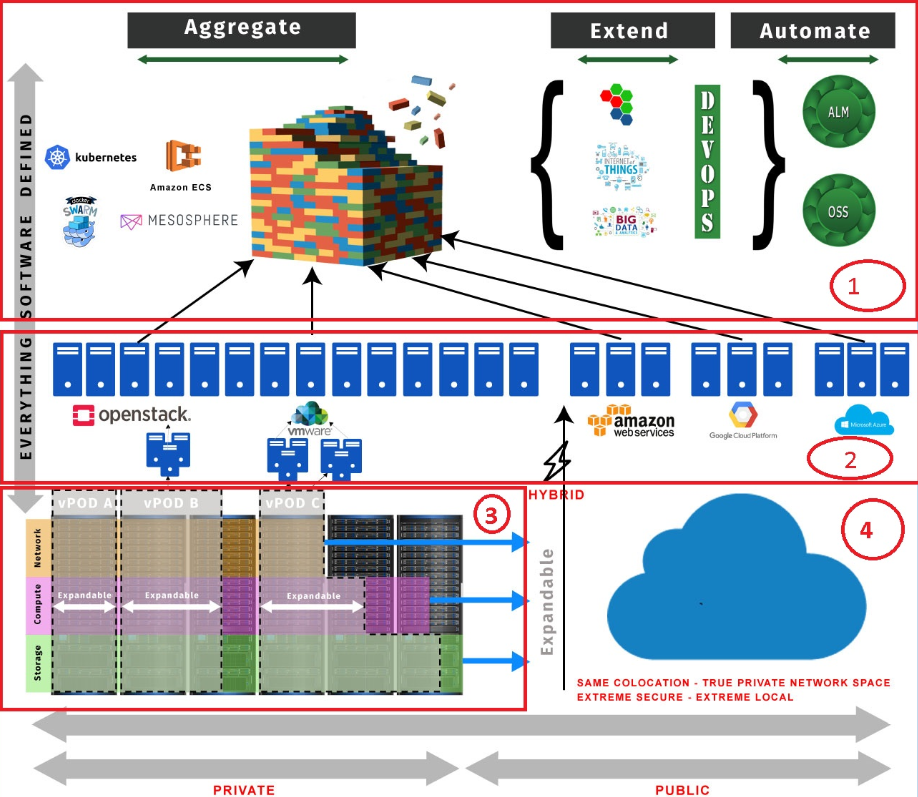
Activites
Aggregate
- Aggregate computing, storage, network @software layer from any plublic/private cloud
- Scale in/out as per need
Extend
- Develop micro service,
IOT, big data quickly - Extend full proof frameworks
DevOps
- Establish build/deployment pipeline
- Establish service orchestration
Operate
- Establish ALM
- Setup operational tools and frameworks to put your business in autopilot mode
Output
- Automated scripts to do end to end provisioning of entire platform in minutes
- Aggregated cluster capable of deploying microservice/IOT/Big Data Application
- Develop micro service,
IOT, big data quickly - Extend full proof frameworks
- Establish build/deployment pipeline
- Establish service orchestration
- Establish ALM
- Setup operational tools and frameworks to put your business in autopilot mode
One Key Cultural Driver.
Simply speaking the microservice world is “Solve small problems, with small teams with measurable outcomes vs solving 1 big problem with 1 large team.”
Since its small teams being responsible for end to end success, it’s much essential to establish a culture that “You built it, you run it”. Dev & Ops married, become DevOps. It means each employee are skilled to Develop small services and able to maintain its complete lifecycle. That involves a big change in structure & skills of the organization. Most of the microservices adoption will be successful if this cultural transformation is done right, we opine that it contributes 90% towards your success. A typical culturally changed organization will look like as below:
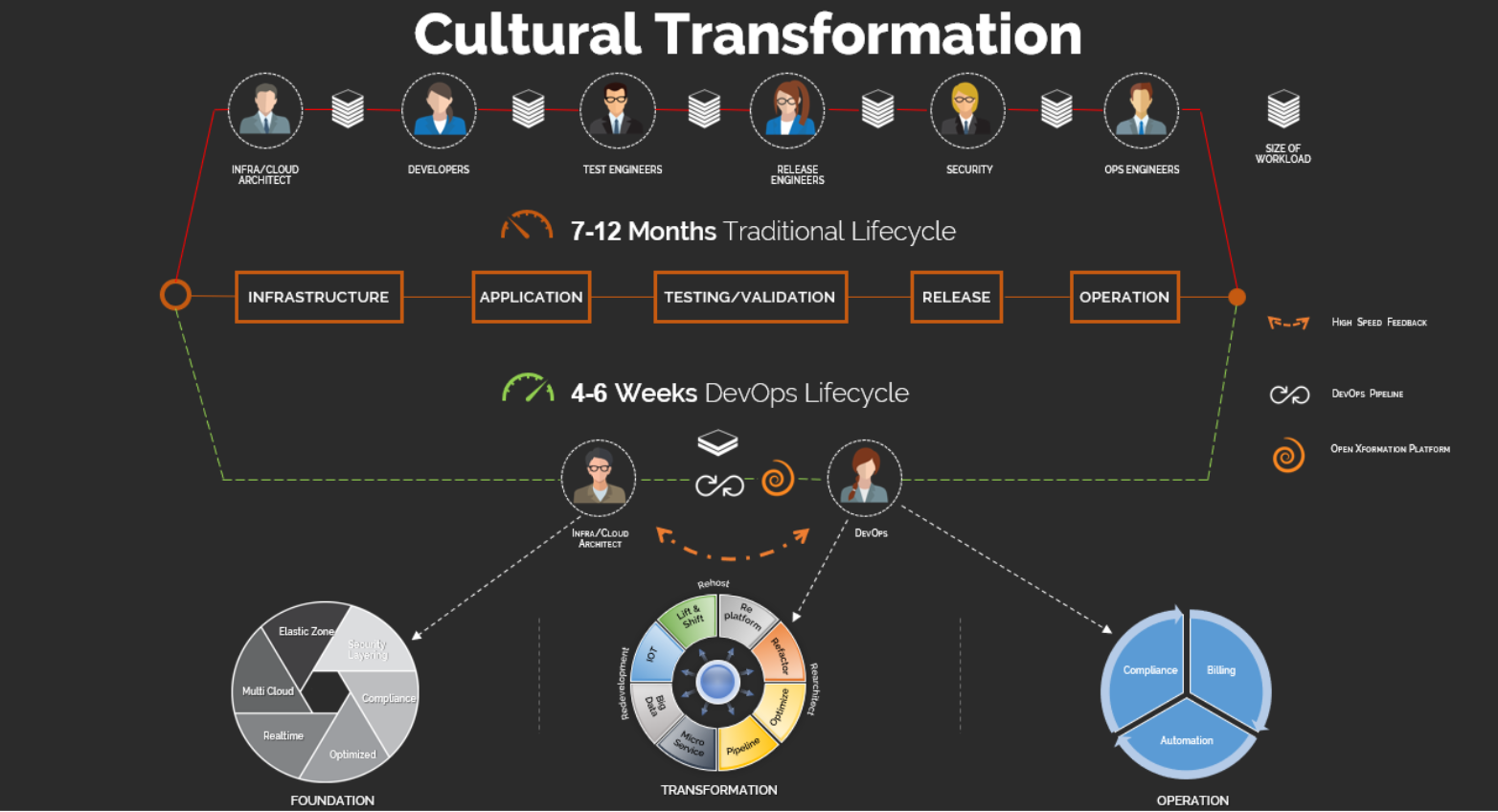
SYNECTIKS, a trusted partner with experience migrating monolithic applications to cloud and microservices architecture, can help make the process seamless. Let us help you make the shift so you can capitalize on business opportunities faster.
SYNECTIKS has a flexible and effective way of migrating monolithic applications to microservices, which includes the following steps:
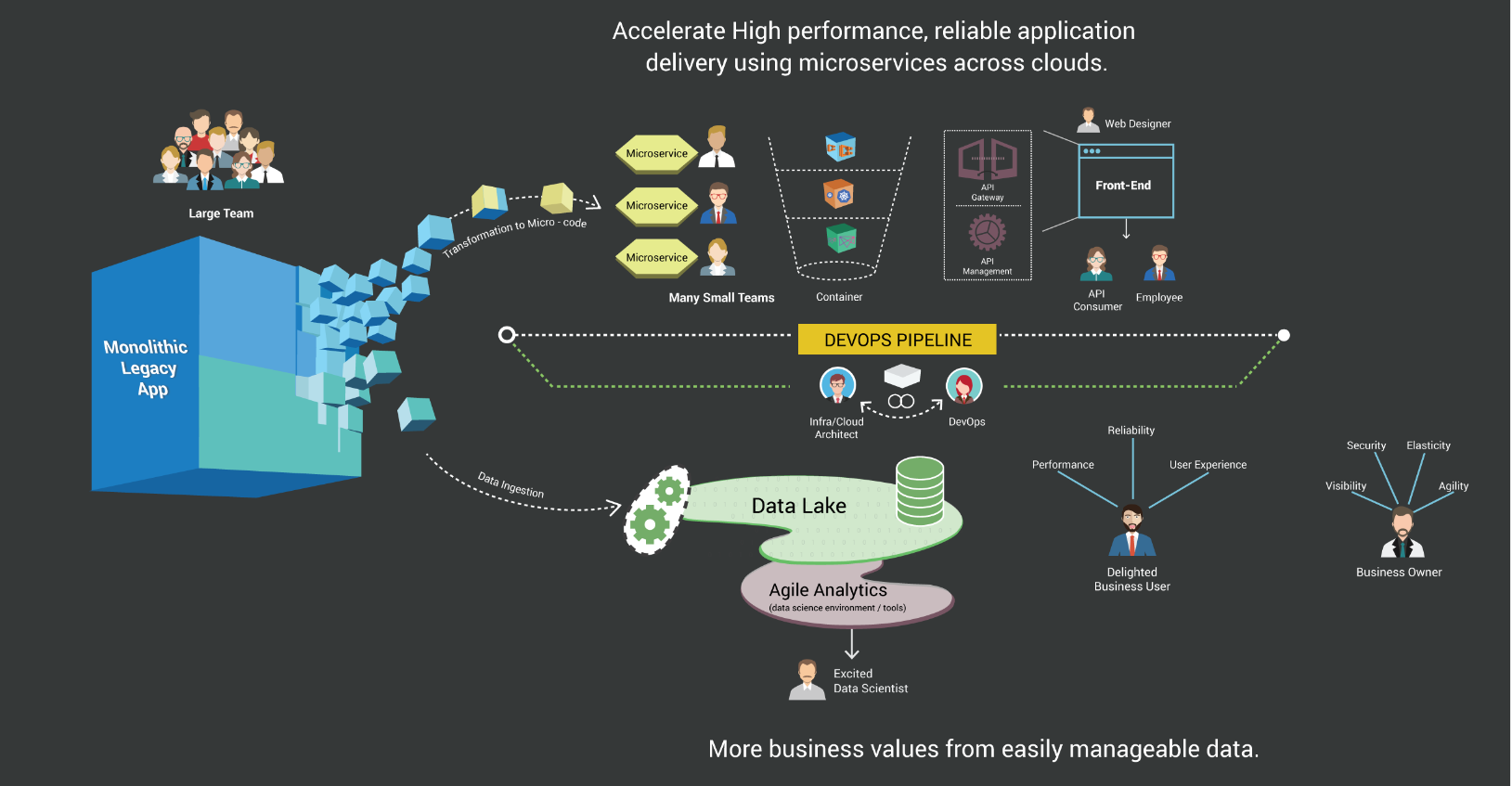
Discovery and Assessment.
- Meet with the Stakeholders, Infrastructure and Application SME’s to gather detailed information about the applications and databases.
Business Readiness.
- Business Transformation Challenges
- Cultural Readiness
Existing Infrastructure and Applications Review.
- Application Functionality
- Infrastructure & Deployment
- Technology Stack
- Data Structure
- Interfaces
- Security & Governance
- Existing Pain Points
Provide modernization options, along with Demo / POC how the transition would look like.
Based on the SYNECTIKS recommendations, provide proposed LOE (Level of Effort) After mutual agreement, SYNECTIKS begins with agile methodology, including:
- Get a deep understanding of the functionality of the existing application.
- Create Migration RoadMap.
- Create Risk Plan.
- Create Target Architectures
- Create a project plan and share with all the stakeholders.
- Split the application into smaller domains.
- Define the boundaries of the domains and microservices.
- Finalize the technology stack.
- Generate infrastructure blueprints.
- Set up the foundation environment Put Continuous Integration/Continuous Delivery (CI/CD) pipelines in place.
- Begin development sprints (SYNECTIKS prefers test-driven development to minimize manual testing).
- Help to use SYNECTIKS Application blocks / libraries to do rapid transformation.
SYNECTIKS is committed to working with its customers to meet almost any need.
- Adapt DevOps culture across organization, essential for developing microservices, foster small, independent teams within the organization to take over ownership of the services.
- Transform your hardware driven infrastructure to a complete multi-cloud hybrid software driven system
- Streamline communications to ensure success
- Embrace CI best practices and automate CI/CD processes
- Embrace operation automations to manage distributed cluster and services With SYNECTIKS Xformation platform, companies can take advantage of an API driven cloud architecture and get going faster.
How much effort it takes to perform a Monolith to Microservices transformation?
Though it depends on complexity & sizing of the existing applications, you could accelerate the transformation process by engaging a microservices SYNECTIKS who can help you as follows:
- Accelerate the transformation by using open application and automation blocks and frameworks built by SYNECTIKS team, so that you can leverage lot of existing code and reuse your maximum existing codebase. A typical large transformation project can take a year long effort and often don’t yield results. We recommend taking bottom - up approach, take a small piece of functionality, and develop the services and foundation for it rapidly by using existing application blocks and automation framework. You would minimize your risks by investing a small time & money and continue to do so when you see a significant ROI. The key aspect is time. The advantage of making us your microservices partner is, our open source contribution helps us to deliver values that vary rapidly.
- Embrace DevOps centric culture by delivering you skilled DevOps resources.
Why SYNECTIKS should be your trusted microservice partner?
